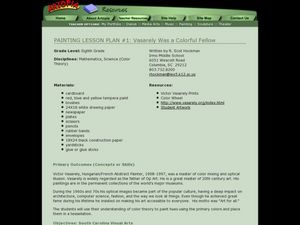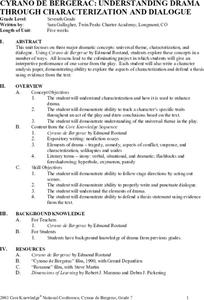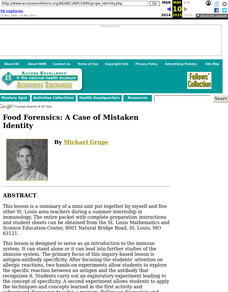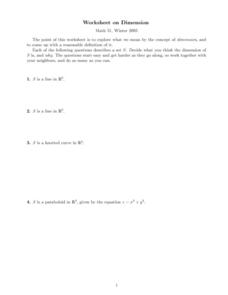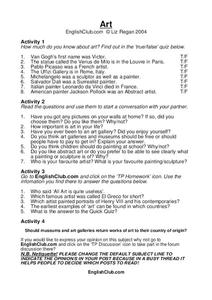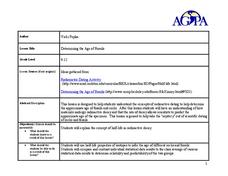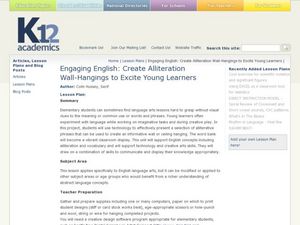Curated OER
Sound--Music or Noise?
Students are introduced to the concept of sound and how it is presented in the world around them. Using scientific terms, they describe the properties of sound and create their own definitions of sound, music, and noise. They demonstrate...
Curated OER
How is a Hot Dog Like a Shoe?
Students create and explain analogies that reveal the depth of their understanding of new concepts.
Curated OER
Molecular Modeling Activity
High schoolers explore the concept of molecular modeling and differentiate between saturated and unsaturated compounds. In small groups, they identify molecular formulas, complete a chart comparing alkanes, alkenes, and alkynes, and...
Curated OER
Consumer Surplus Lesson Plan: 1 X 1 Hour Lesson
Students investigate the concept of consumer surplus as it relates to economic policy and decision making. They determine the difference between the value they place on something as compared to the price that they actually pay for it...
Curated OER
Linking Lines to Landscape
Students evaluate art to enhance their core knowledge of fiction, American folk heroes, and the water cycle. In this art lesson, students complete a unit of activities to use art to study various topics of literature, history, and...
Curated OER
Vasarely Was A Colorful Fellow
Eighth graders create artwork inspired by the work of Victor Vasarely. In this op art lesson plan, 8th graders explore color theory and color mixing. Students create ten shapes to use in their artwork and over the course of two weeks,...
Curated OER
Identify the Element of Line
Learners explore the element of "line." In this beginning art lesson, students listen to the book Harold and the Purple Crayon, then describe the types of lines Harold drew. Learners identify straight lines, jagged lines, curvy lines,...
Curated OER
Awareness of Pre-algebra Concepts
Students work in a cooperative group of three to solve algebraic equations with roles assigned for manipulator, recorder, and checker. They utilize hands-on learning materials imbedded in the lesson plan.
Curated OER
A Little Kandinsky For All
Learners create abstract compositions based on the later works of Wassily Kandinsky using the primary colors in this early elementary Art lesson. The lesson emphasizes the use of color, lines, and shapes to create the abstract works of...
Curated OER
Introduction to Toxicology
Students explore the science of toxicology and the relationship between a toxic reaction (response) and amount of substance (dose). They observe two demonstrations illustrating the concept of dose-response.
Curated OER
Cyrano De Bergerac: Understanding Drama Through Characterization and Dialogue
Students explore three major dramatic concepts using Cyrano de Bergerac by Edmond Rostand. In this dramatic concepts lesson, students research the concepts of universal theme, characterization, and dialogue using the given text. Students...
Curated OER
Food Forensics: A Case of Mistaken Identity
Ninth graders explore the specific reaction between an antigen and the antibody that recognizes it. They carry out an exploratory experiment leading to the concept of specificity.
Curated OER
Probability and Sports
Students explore the concept of probability in sports. In this probability in sports lesson, students research a sport that they enjoy. Students find probability information related to their sport. Students share their findings with the...
Curated OER
Gandhi on Poverty, Violence, and Well-Being of All
Eighth graders explore the concept of Sarvodaya. In this nonviolent resistance instructional activity, 8th graders listen to a lecture about Gandhi's teachings and determine how poverty is a form of violence.
Curated OER
Perimeter
Young scholars examine the concept of perimeter. Students calculate the perimeter of a random shape on a grid. Young scholars develop a better understanding of the concept of perimeter. Students calculate the perimeter of shapes.
Curated OER
Laws of Motions
Seventh graders explore the Laws of Motion. They define friction and explain the concept of inertia. Students explain what happens when a force is exerted on an object that is in equilibrium. They state the second and third laws of motion.
Curated OER
Worksheet on Dimension
In this dimension worksheet, students describe the dimension of a line, a knotted curve, an abstract set, explore a paraboloid. This two-page worksheet contains eight problems.
Curated OER
Art
In this artistic knowledge worksheet, students examine and discuss the concept of art. Students take a quiz to see how much they know about art history, and discuss questions pertaining to the rights that museums have regarding famous...
Curated OER
Determining the Age of Fossils
Students examine the concept of radioactive dating. In this radioactive dating lesson plan, students investigate how to determine the ages of fossils and rocks as they learn about half-life radioactive decay.
Curated OER
Fire!, Probability, and Chaos
Students explore the concept of probability. In this probability lesson, students simulate a controlled forest burn using an applet. Students vary the probability of trees burning and predict what will happen.
Curated OER
Vocab Grabbing the Preamble to the U.S. Constitution
Students identify concrete and abstract nouns in the preamble to the Constitution, and complete Frayer Model graphic organizers using history and current events as examples of American values. For this preamble lesson plan, students use...
Curated OER
Teaching Language Arts with Sayings and Phrases
Students complete a unit to learn sayings and phrases that help them understand language art concepts. In this sayings and phrases lesson, students complete 11 lessons that use common sayings and phrases to teach language art concepts...
Curated OER
Engaging English: Create Alliteration Wall-Hangings to Excite Young Learners
Students explore the concept of alliteration. In this sound devices lesson, students use educational software to create alliterative phrases that are accompanied by appropriate clip art, design tools, and graphics.
Curated OER
Is the System Fair?
Students investigate shapes and patterns. In this algebra lesson plan, students move from concrete to abstract understanding of shapes and concepts. They use variable to identify the unknown.







